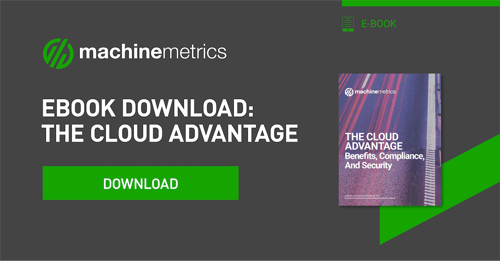Key Takeaways:
- Cloud technology enables real-time data access, improving communication and decision-making on the production floor.
- Manufacturers benefit from streamlined workflows and reduced downtime by utilizing cloud-based solutions.
- Cloud platforms offer scalability and flexibility, making them ideal for optimizing manufacturing processes.
Cloud-based technologies are connecting plants, people, and machine data in ways like never before. Given today’s fast-paced and highly-distributed industrial environments, along with the criticality of optimized maintenance management, operations and maintenance teams in the manufacturing industry experience substantial competitive advantages with cloud-based technologies.
Traditional Enterprise Resource Planning (ERP) systems do not provide quick and remote access to the necessary information to inform decision making. With the distributed nature of workforces as well as assets and fleet, this is a key challenge for competitiveness in today’s world.
On the other hand, cloud-based ERP, maintenance, and other industrial software solutions, provide similar or better functionality and more flexibility that their on-premise counterparts. Oftentimes at a fraction of the cost of traditional systems. Cloud solutions also offer cross-functional visibility and consistent data accessibility across functions and platforms, faster low-cost upgrades, lower operational costs, and usually come with OEM guaranteed security of internal customer data.
Manufacturers are increasingly embracing cloud-based technology and bringing innovation directly to the production floor and assembly line through IoT platforms such as MachineMetrics.
Below, we outline some of the key benefits that cloud technology can bring to the workflow improvements in your production floor.
Lower capital cost
The exponential growth of data-driven information systems demands a highly scalable infrastructure for the collection, processing, and analyses of a huge quantity of data in real-time, and a cloud-based system is one that can support those demands.
The biggest cost-saving aspect of cloud-based technology is the lack of on-site IT infrastructure needs. While on-premise solutions require hardware, real estate space, and specialized staff members, a cloud-based software requires only a stable Internet connection to function. That means a lower upfront capital cost commitment.
The savings on hardware is particularly significant on the cost front. One of the biggest chunks of expenses of an on-premise alternative is the data servers you would have otherwise needed. You not only had to buy and set them up, but also maintain them as well - further adding to your already large asset maintenance plan.
Functionality and flexibility
Cloud solutions, due to their flexible platforms and customer-focused product development approach, offer robust functionality out of the box, often eliminating the need for ad-hoc spreadsheet tracking. In addition, cloud architecture enables rapid development.
With the increased globalization of the manufacturing value chain, using cloud-based technology and services is one of the only answers to many of the challenging questions such as providing process and procedural compliance transparency beyond the bounds of just a single plant.
Cloud-based technologies generally offer functionalities that are beyond that of the traditional on-premise solutions. For example, MachineMetrics provides a whole host of workflow improvements that benefit manufacturers by implementing automation on the production floor - saving time, increasing productivity, and improving capacity. These improvements include areas such as downtime events and categorization, anomaly detection, and quality inspection, among others.
Additionally, a cloud-based approach helps you leverage state-of-the-art AI technologies. If you're monitoring multiple equipment parameters such as vibration, temperature, torque, there are several different ways you can use that data. First is the traditional method of using established physical thresholds to trigger condition-based maintenance. The other approach is an empirical machine learning approach, where you take big data sets and you try to identify patterns that would then correlate with certain indications of failure, which forms the basis of predictive maintenance. Scalable cloud-based solutions can support both approaches.

Remote access
Remote diagnostics, troubleshooting, and system health monitoring are the key frontiers of modern advanced maintenance and asset management strategies.
One of the emerging benefits attributed to cloud-based asset monitoring and maintenance management is the ability to tap into a much wider pool of experts and technicians. Now team members can easily add and modify work orders, look up maintenance histories, equipment alarm summaries, from anywhere in the world. For example, the features provided by MachineMetrics workflows help streamline and automate processes using automation based on triggers (e.g. alarms, inactivity) followed by actions, such as sending out notifications to the correct plant stakeholder(s).
Organizations can be empowered to utilize an enterprise or fleet-wide approach and no longer have to operate each facility in a “silo”. This means that an expert at one plant location can provide more value to the company by being able to provide their consultation to other plants in the fleet as well. This eliminates a company's need to have an expert for everything at each location, and the expertise available throughout all facilities can now be shared according to priority.
Additionally, remote access provides team members widespread access to non-technical information as well, such as inventory, sales and purchase information — even when key staff are off-site.
Mobility and collaboration
Cloud solutions provide centralized and integrated data across multiple functions of an organization, with accessibility across multiple platforms.
By collecting data in real-time, plant operators and maintenance members have access to accurate information for collaborative decision-making. It enables teams to react swiftly to dynamic working conditions and changing environments, and continually re-calibrate business bottom-line results. This constant re-optimization is the agility that most businesses are looking for to meet the ever-evolving dynamic customer demand.
A cloud-based technology facilitates improved collaboration capabilities through real-time multi-platform connectivity and compatibility, and also plays a part in keeping employees and leaders engaged at all times. Cloud solution truly helps integrate people, places, and processes that form the core ethos of maintenance management.
Fast and affordable upgrades
Due to the multi-tenant architecture of cloud-based technologies, system upgrades can happen rather seamlessly behind the scenes and customizations can be carried through in the new releases. Such a service model ensures your systems are on par with industry best practices and equipped with state of the art technologies. It enables rapid delivery of new features and functions to all customers, freeing manufacturers from the burden of installing and configuring the upgrades themselves.
Data security
Vendors providing cloud-based technology product solutions can take the burden of data security and backup off from your company and let you focus on your core competency. Because they are hosting data for a large number of clients, they can afford more robust security measures. This is typically achieved through the use of advanced server authentication, data encryption technology, and cyber-security protocols. As a result, cloud solution providers can almost always provide better data security and safety than most manufacturers can achieve themselves.
Parting thoughts
As you can see, cloud-based technologies provide many benefits. The possibilities for workflow automation and their benefits that reach all the way to the production floor are virtually endless. Their highly customizable and hands-off nature are two of the underappreciated aspects, which is leading more and more businesses to shift towards their adoption and realize the resultant business efficiency gains.
Bryan Christiansen is the founder and CEO of Limble CMMS. Limble is a modern, easy to use mobile CMMS software that takes the stress and chaos out of maintenance by helping managers organize, automate, and streamline their maintenance operations.


.png?width=1960&height=1300&name=01_comp_Downtime-%26-Quality_laptop%20(1).png)


.gif)









Comments